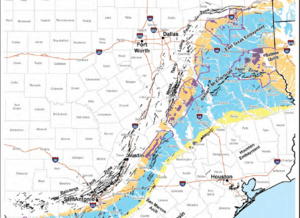Balcones Fault facts for kids


The Balcones Fault is a long crack in the Earth's crust in Texas. It's actually a group of many smaller cracks, or faults. This fault zone stretches from near Del Rio in the southwest to near Dallas in the north. It generally follows the path of Interstate 35.
When we say "fault," it means a place where the Earth's rocky layers have broken. Along the Balcones Fault, the ground on one side has mostly moved downwards compared to the other. This type of break is called a normal fault. Sometimes, blocks of land drop down to form valleys (called grabens). Other times, blocks are pushed up, creating raised areas (called horsts). The Mount Bonnell Fault is one well-known part of this system.
Contents
How the Balcones Fault Formed
The Balcones Fault zone might be linked to some very old mountains. About 300 million years ago, two huge landmasses collided. This created the Ouachita Mountains. These mountains have worn away in Texas over millions of years.
However, the deep "roots" of these ancient mountains are still buried far underground. This buried area might be a weak spot in the Earth's crust. When forces inside the Earth cause stress, this weak spot can become a place where new faults form.
Is the Fault Active?
The Balcones Fault has been quiet for a very long time. It hasn't moved in nearly 15 million years. The last time it was active was during a period called the Neogene. This movement was likely caused by the land sinking along the Texas coast. This sinking happened because Texas rivers deposited huge amounts of sand and mud onto the coastal plain.
Because it has been inactive for so long, the Balcones Fault is in one of the safest zones in the United States for earthquakes. The risk of a major earthquake here is very low.
The Balcones Escarpment
One of the most noticeable features of the Balcones Fault is the Balcones Escarpment. An escarpment is a long, steep slope or cliff. This escarpment forms a natural border. It marks the eastern edge of the Texas Hill Country. It also forms the western edge of the flatter Texas Coastal Plain. You can see cliffs and steep hills along this line.
Water and Wildlife
The fault zone is also home to many interesting natural features. You can find underground caves, like Wonder Cave, along the fault. These caves formed because water seeped into cracks in the rocks.
Many important springs are also found here. Springs like San Pedro Springs, Comal Springs, San Marcos Springs, Barton Springs, and Salado Springs provide fresh water. This fresh water has made the area a good place for people to live for a very long time.
The Balcones Fault also acts as a natural boundary for some plants and animals. For example, the California fan palm is a type of palm tree. It is the only native palm found in the continental United States west of the Balcones Fault. This shows how the fault can divide different natural environments.


